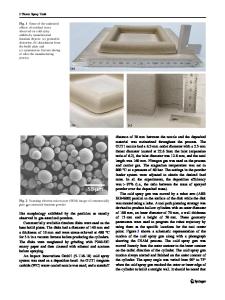Design optimization of additively manufactured titanium lattice structures for biomedical implants
- PDF / 1,613,856 Bytes
- 12 Pages / 595.276 x 790.866 pts Page_size
- 101 Downloads / 355 Views
ORIGINAL ARTICLE
Design optimization of additively manufactured titanium lattice structures for biomedical implants Mahmoud Ahmed El-Sayed 1 & Khamis Essa 2 & Mootaz Ghazy 1 & Hany Hassanin 3 Received: 28 April 2020 / Accepted: 20 August 2020 # Springer-Verlag London Ltd., part of Springer Nature 2020
Abstract A key advantage of additive manufacturing (AM) is that it allows the fabrication of lattice structures for customized biomedical implants with high performance. This paper presents the use of statistical approaches in design optimization of additively manufactured titanium lattice structures for biomedical implants. Design of experiments using response surface and analysis of variance was carried out to study the effect design parameters on the properties of the AM lattice structures such as ultimate compression strength, specific compressive strength, elastic modulus, and porosity. In addition, the lattice dimensions were optimized to fabricate a diamond cellular structure with properties that match human bones. The study found that the length of a diamond-shaped unit cell strut is the most significant design parameter. In particular, the porosity of the unit cell increases as the strut length increases, while it had a significant reverse effect on the specific compressive strength, elastic modulus, and ultimate compression strength. On the other hand, increasing the orientation angle was found to reduce both the specific compressive strength and modulus of elasticity of the lattice structure. An optimized lattice structure with strut diameter of 0.84 mm, length of 3.29 mm, and orientation angle of 47° was shown to have specific compressive strength, elastic modulus, ultimate compression strength, and porosity of 37.8 kN m/kg, 1 GPa, 49.5 MPa, and 85.7%, respectively. A cellular structure with the obtained properties could be effectively applied for trabecular bone replacement surgeries. Keywords Additive manufacturing . Implants . Porosity . Powder bed fusion . Lattices
1 Introduction Lattice structures are 3D open-celled porous structures which are topologically ordered and formed of repeatable units [1]. There are lattice structures available on nature such as wood, cork, and bone (natural materials) as well as foam, honeycomb, and sponges (synthetic technical materials). Typically, porous structures are classified into stochastic and non-stochastic. Lattice structure unit cells are composed of several struts connected at nodes. The unit cell is usually characterized by strut dimensions and connectivity. Despite that
* Hany Hassanin [email protected] 1
Department of Industrial and Management Engineering, Arab Academy for Science and Technology and Maritime Transport, Box 1029, Abu Qir, Alexandria, PO 21599, Egypt
2
University of Birmingham, B15 2TT, Birmingham, UK
3
School of Engineering Technology and Design, Canterbury Christ Church University, Canterbury CT1 1QU, UK
they are typically considered to have microstructures at the micro-scale level, they act as meta-materials when considerin
Data Loading...











